You are using an out of date browser. It may not display this or other websites correctly.
You should upgrade or use an alternative browser.
You should upgrade or use an alternative browser.
rackhunter
Member
I have been told to spray Simizine and Prowl around newly planted trees and also sounds like this works for year old planted cedars.
Will this combination of spray take care of the grasses that are already up or just future weeds and grass? Should i spray something else with this combo or use Roundup during another spraying?
Thanks
Will this combination of spray take care of the grasses that are already up or just future weeds and grass? Should i spray something else with this combo or use Roundup during another spraying?
Thanks
dbltree
Super Moderator
I have been told to spray Simizine and Prowl around newly planted trees and also sounds like this works for year old planted cedars.
Will this combination of spray take care of the grasses that are already up or just future weeds and grass? Should i spray something else with this combo or use Roundup during another spraying?
Thanks
I use roundup before trees are budded or candled to kill grasses, if they bud out then use clethodim and crop oil with the mix. Simazine and Prowl are the most effective combination I have used but on cedars and oaks you can add 1-2 ounces of Oust/Spyder to the mix to make it even more effective for a longer period of time but do NOT use Oust on shrubs and fruit trees
spltbrow
Member
Going to be spraying atrazine and dual ii magnum for a switch grass field this weekend and was wandering if I could use this mix in an area that I am going to be planting some oaks, conifers, and some shrubs or if I need to spray that area with something else.
Also can I mix gly with this combo?
Also can I mix gly with this combo?
dbltree
Super Moderator
Going to be spraying atrazine and dual ii magnum for a switch grass field this weekend and was wandering if I could use this mix in an area that I am going to be planting some oaks, conifers, and some shrubs or if I need to spray that area with something else.
Also can I mix gly with this combo?
Yes and yes...avoid spraying over the top of budded or candled trees obviously but otherwise it's a very effective mix.
dbltree
Super Moderator
Tree Screens
I still see too many fields wide open and exposed to roadways where deer are vulnerable to poachers or even neighbors who may be tempted to do something they otherwise would not.
Tree screens are imperative and conifers make the best screens anywhere across the country! Here is an example of a red cedar screen planted by a previous landowner, then a barbed wire fence erected afterwards by the new landowner...both important in keep deer safe and poachers out!
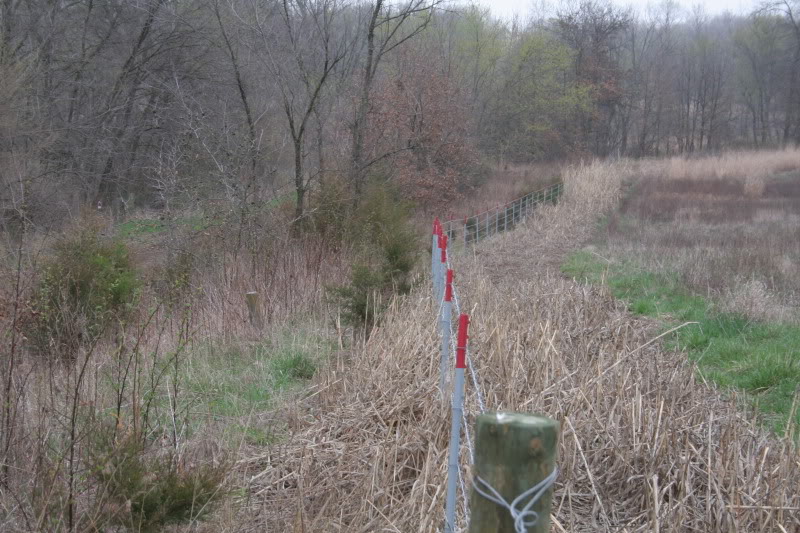
While the trees are growing I plant Egyptian Wheat screens adjacent to the fence and trees
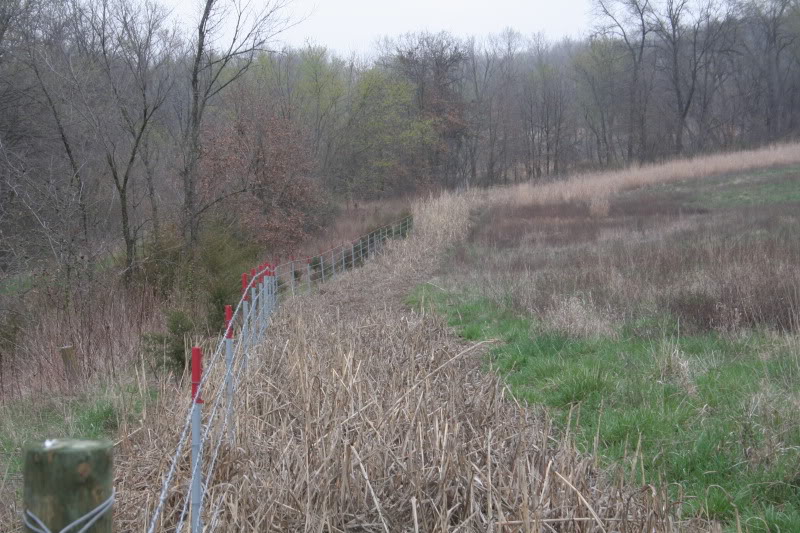
Eventually the field will be protected for many lifetimes when the cedars mature...in the meantime the fence makes it difficult for a poacher to just "run out in the field" with emphasis on "difficult"....certainly not impossible. The Egyptian Wheat lasts thru the fall and early winter to keep things hidden as the trees grow.
On top of that we are planting a mix of Cave In Rock and Kanlow switchgrass in the field area to further insulate and protect the whitetails living there.
In Iowa...it's tough to grow anything but red cedars because bucks will scrub any other conifers to death each fall but in northern states deer may find the cedars a delicacy during winter months and there Norway spruce may be a better option.
On a recent trip to speak at a QDMA seminar a few members took me on a tour of their farms and shared their spruce plantings
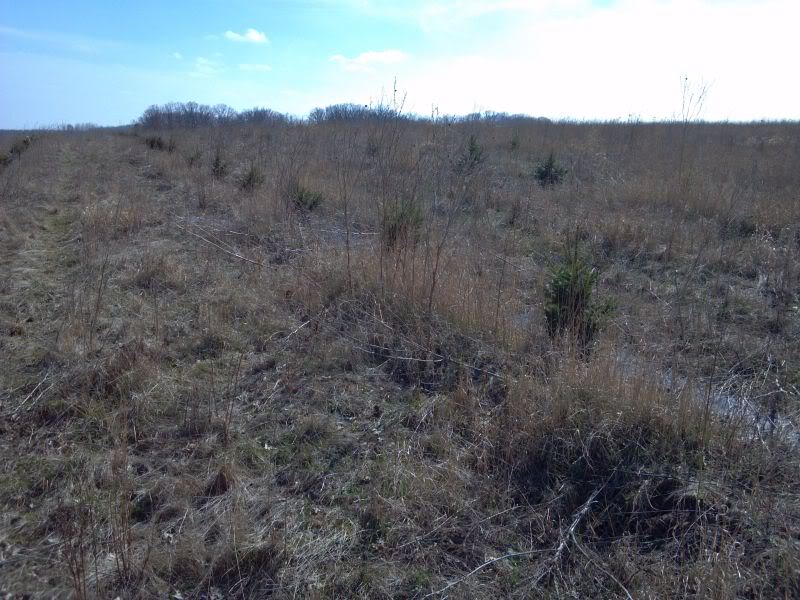
These spruce were planted 25 years ago by a member and his dad and now it is outstanding bedding cover and screening
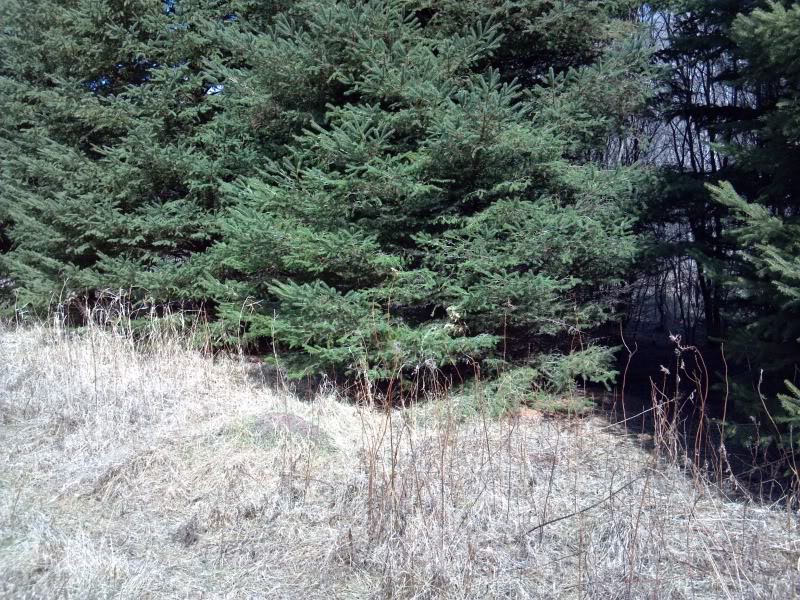
Conifers are an essential element in you habitat tool chest and those with the foresight to plant them will be rewarded richly in due time. Make screening a priority and use any combination that will work for you in your area to get the job done, then add conifers and NWSG in appropriate areas to increase bedding cover areas.
North Central Reforestation carries all types of conifers
Prairie seed Farms carries all types of switchgrass seed
Iowa-Missouri Hybrids will ship small quantities of EW seed...call Aaron Palm at 641-919-1695 to order :way:
I still see too many fields wide open and exposed to roadways where deer are vulnerable to poachers or even neighbors who may be tempted to do something they otherwise would not.
Tree screens are imperative and conifers make the best screens anywhere across the country! Here is an example of a red cedar screen planted by a previous landowner, then a barbed wire fence erected afterwards by the new landowner...both important in keep deer safe and poachers out!

While the trees are growing I plant Egyptian Wheat screens adjacent to the fence and trees

Eventually the field will be protected for many lifetimes when the cedars mature...in the meantime the fence makes it difficult for a poacher to just "run out in the field" with emphasis on "difficult"....certainly not impossible. The Egyptian Wheat lasts thru the fall and early winter to keep things hidden as the trees grow.
On top of that we are planting a mix of Cave In Rock and Kanlow switchgrass in the field area to further insulate and protect the whitetails living there.
In Iowa...it's tough to grow anything but red cedars because bucks will scrub any other conifers to death each fall but in northern states deer may find the cedars a delicacy during winter months and there Norway spruce may be a better option.
On a recent trip to speak at a QDMA seminar a few members took me on a tour of their farms and shared their spruce plantings

These spruce were planted 25 years ago by a member and his dad and now it is outstanding bedding cover and screening

Conifers are an essential element in you habitat tool chest and those with the foresight to plant them will be rewarded richly in due time. Make screening a priority and use any combination that will work for you in your area to get the job done, then add conifers and NWSG in appropriate areas to increase bedding cover areas.
North Central Reforestation carries all types of conifers
Prairie seed Farms carries all types of switchgrass seed
Iowa-Missouri Hybrids will ship small quantities of EW seed...call Aaron Palm at 641-919-1695 to order :way:
dbltree
Super Moderator
April 13th, 2012
Tree Planting time! This time of year is a busy one around here as we hurry to get thousands of seedlings in the ground. It's always best of course if you can plant immediately upon receiving the the seedlings but that's not always possible. If trees need to be held for a few days, keep them in a cool dark place like a basement or better yet a cooler. NEVER leave seedlings in a bucket of water for days...they will drown! Roots should be kept moist however so use shredded newspaper or sphagnum moss wrapped around the roots and soaked down in buckets or tubs.
If seedlings need to be kept for a week or two, heel them in by digging a trench and spreading out the seedlings and covering the roots with soil and continue to keep them well watered until planting.
Our first set of seedlings were red cedars that needed to be planted in an area hinge cut the previous winter
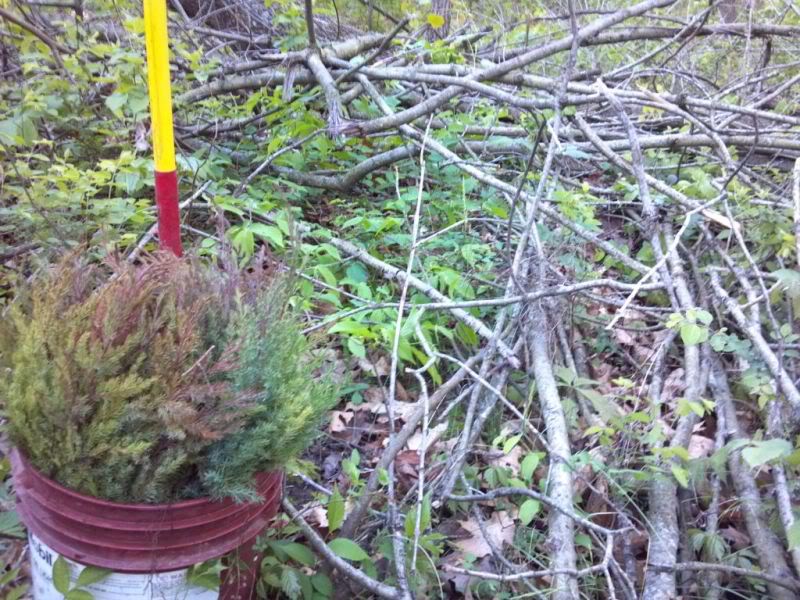
A daunting challenge since the area has grown into some what of a jungle!



Tree planting bags can work to carry seedlings but I prefer a 5 gallon bucket with 3-4" of water in it...it's easier to get the seedlings out yet the bucket protects them from drying winds and the water keeps the roots moist while planting.
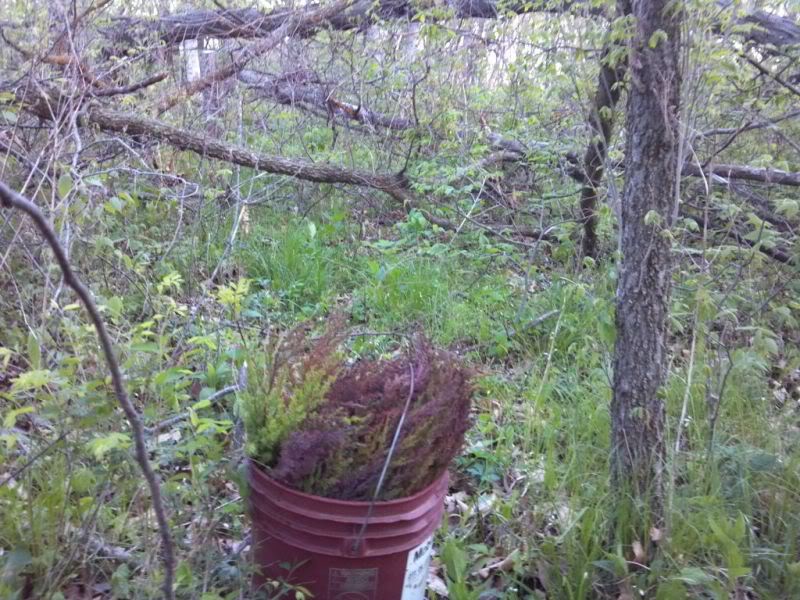
My son prefers the dibble bar but I like using a shovel...partly because I like to scrape away leaves and debris first
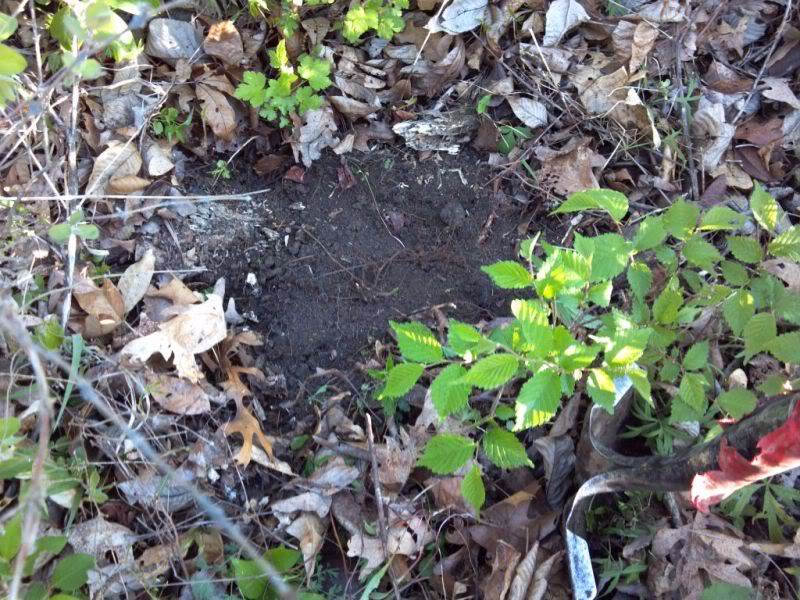
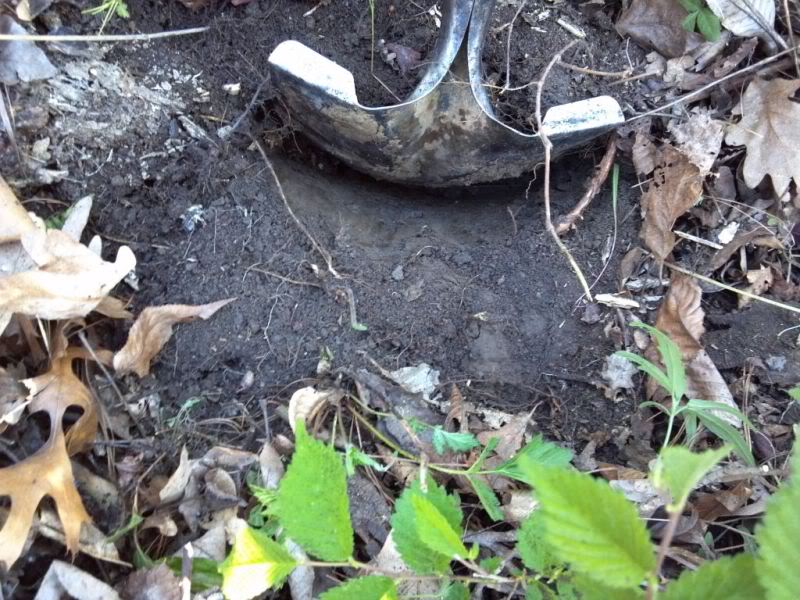
The cedar roots are long and a little difficult to fit into the narrow hole made by the dibble bar but easier to slide into the area opened with a shovel
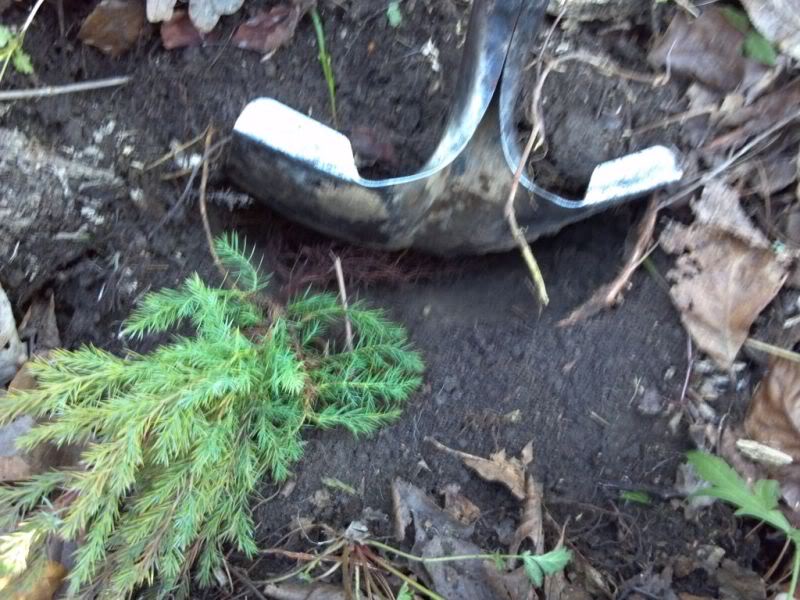
We stumbled thru the brush and planted the seedlings amongst the downed tree tops

and any openings we could find
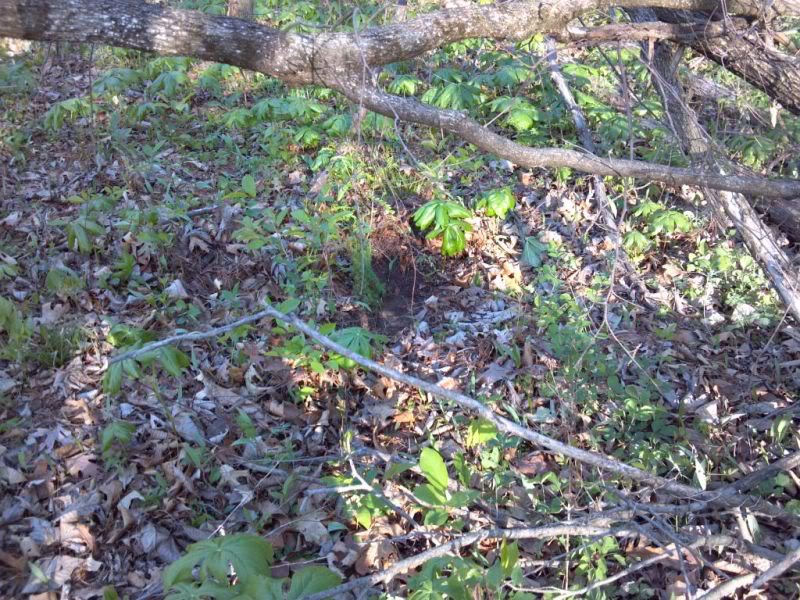
Next set will be with the tree planter...the same only different....
Tree Planting time! This time of year is a busy one around here as we hurry to get thousands of seedlings in the ground. It's always best of course if you can plant immediately upon receiving the the seedlings but that's not always possible. If trees need to be held for a few days, keep them in a cool dark place like a basement or better yet a cooler. NEVER leave seedlings in a bucket of water for days...they will drown! Roots should be kept moist however so use shredded newspaper or sphagnum moss wrapped around the roots and soaked down in buckets or tubs.
If seedlings need to be kept for a week or two, heel them in by digging a trench and spreading out the seedlings and covering the roots with soil and continue to keep them well watered until planting.
Our first set of seedlings were red cedars that needed to be planted in an area hinge cut the previous winter

A daunting challenge since the area has grown into some what of a jungle!



Tree planting bags can work to carry seedlings but I prefer a 5 gallon bucket with 3-4" of water in it...it's easier to get the seedlings out yet the bucket protects them from drying winds and the water keeps the roots moist while planting.

My son prefers the dibble bar but I like using a shovel...partly because I like to scrape away leaves and debris first


The cedar roots are long and a little difficult to fit into the narrow hole made by the dibble bar but easier to slide into the area opened with a shovel

We stumbled thru the brush and planted the seedlings amongst the downed tree tops

and any openings we could find

Next set will be with the tree planter...the same only different....
medicsnoke
Member
Couple different questions for ya,
My neighbor offered me around 1,000 white oak trees. She says they are 3-4 year old and they are about 16-24 inches tall. They are about to be tilled under due to her renting the ground for farming. She said I can have them for .25 cents a piece. Whats the best way I can go about transferring these? Can I bare root these and plant them with the method just described?
Also, I planted 8 fruit trees last fall. What can i do to make these grow as fast as possible? I was thinking about putting some cow manure around the bases and feeding them a fertilizer spike.
Thanks in advance Dbltree
My neighbor offered me around 1,000 white oak trees. She says they are 3-4 year old and they are about 16-24 inches tall. They are about to be tilled under due to her renting the ground for farming. She said I can have them for .25 cents a piece. Whats the best way I can go about transferring these? Can I bare root these and plant them with the method just described?
Also, I planted 8 fruit trees last fall. What can i do to make these grow as fast as possible? I was thinking about putting some cow manure around the bases and feeding them a fertilizer spike.
Thanks in advance Dbltree
They are about to be tilled under due to her renting the ground for farming. She said I can have them for .25 cents a piece. Whats the best way I can go about transferring these?
Also, I planted 8 fruit trees last fall. What can i do to make these grow as fast as possible? I was thinking about putting some cow manure around the bases and feeding them a fertilizer spike.
Thanks in advance Dbltree
She wants $.25 for trees that are about to be tilled?! And you have to dig them up!?!?! That's kinda funny. That's a lot of work right there! If it were me, I'd only get a few because of the heavy work load. Let us know how this goes. :grin:
For fruit trees, get some triple 13, get around drip line, I like putting in shovel creases around drip line to get in the ground. 1 lbs per 1" trunk diameter is what I do.
letemgrow
PMA Member
Couple different questions for ya,
My neighbor offered me around 1,000 white oak trees. She says they are 3-4 year old and they are about 16-24 inches tall. They are about to be tilled under due to her renting the ground for farming. She said I can have them for .25 cents a piece. Whats the best way I can go about transferring these? Can I bare root these and plant them with the method just described?
Also, I planted 8 fruit trees last fall. What can i do to make these grow as fast as possible? I was thinking about putting some cow manure around the bases and feeding them a fertilizer spike.
Thanks in advance Dbltree
You would be better off buying seedlings from the IA State Nursery if she wants to charge you 25 cents each....Do you have to dig them up? If so, I would be buying some from a state nursery, IA, MO or if you home state has them, you are better off that way.
BBD Big Buck Down
Member
What do you guys think about using Austrees Hybrid willows as a screen? anyone heard much about them? They are suppose to grow very fast and pretty tall and be a good screen. Found a guy on craigslist selling seedlings for 1.50 a piece. Here is a pic of them.




Last edited:
I'd do a row of those and then a row of cedars. Obviously long term the cedars will be better & they don't lose their leaves BUT stuff like the willows are a great option to add with another row as they do grow fast. Personally, I like doing 3 rows of plantings if able but I'm sure 2 rows would be fine.
dbltree
Super Moderator
Haven't tried these but the Thuja Green Giants seem like a better screening option
Thuja Nursery
Another Thuja Nursey
Thuja Info Sheet
Thuja Nursery
Another Thuja Nursey
Thuja Info Sheet
loneranger
Well-Known Member
Just be careful when you put them outside. The shock of full sun,and outdooor air might set them back. I had that happen to some Perssimons I grew in the house, and brought outside.
dbltree
Super Moderator
April 30th, 2012
Another batch of seedlings arrived a few weeks back and of course arrived a few days before we could plant them. I picked up some peat moss...
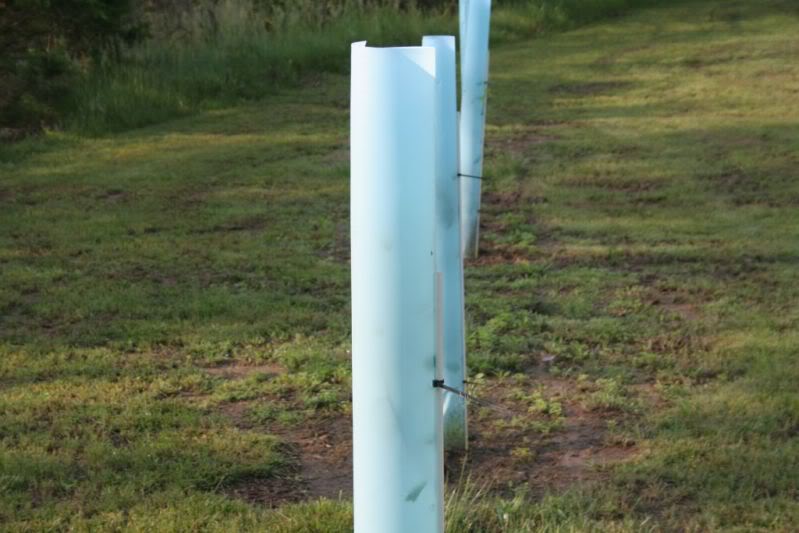
Mixed it up with water

and added it to the wet newspaper
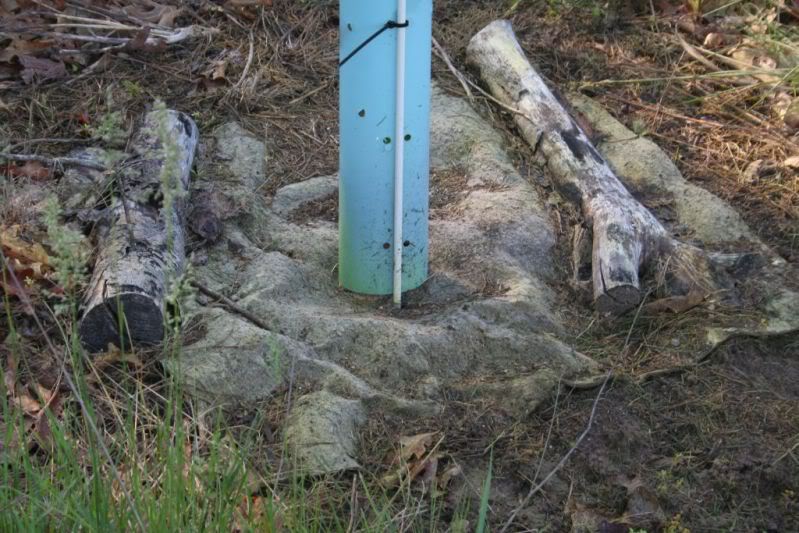
to be certain the roots stayed moist until we could plant
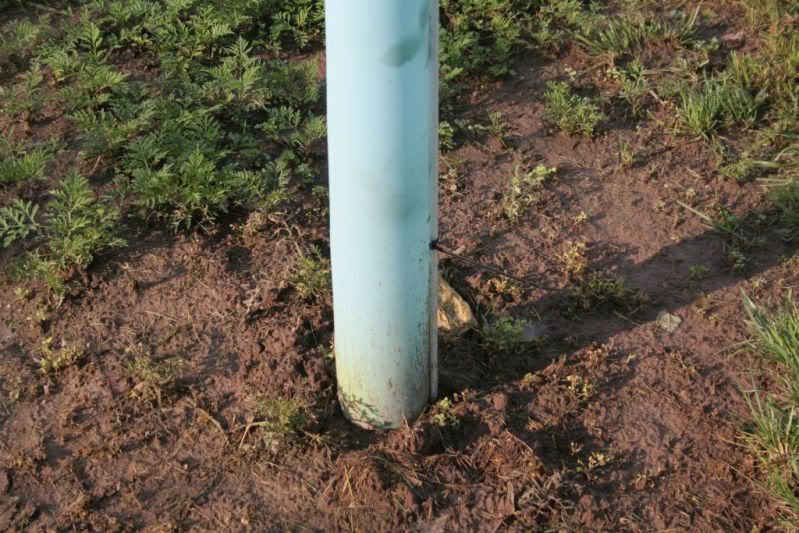
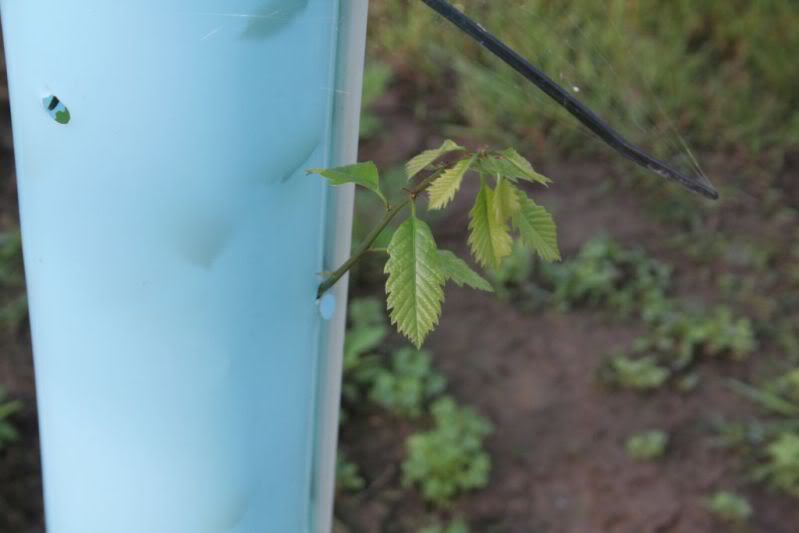
Compared to hand planting, using a tree planter is a breeze and my son and I put several thousand in the ground in no time
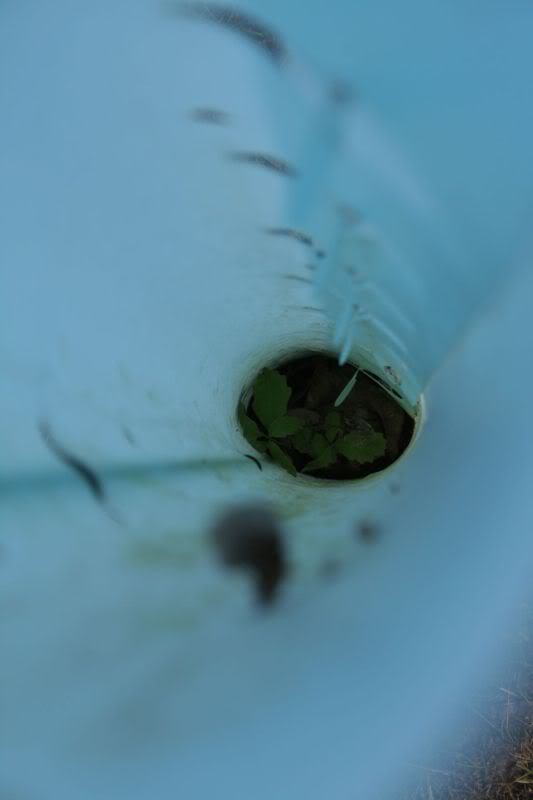
In all cases we planted the cedars for tree screens

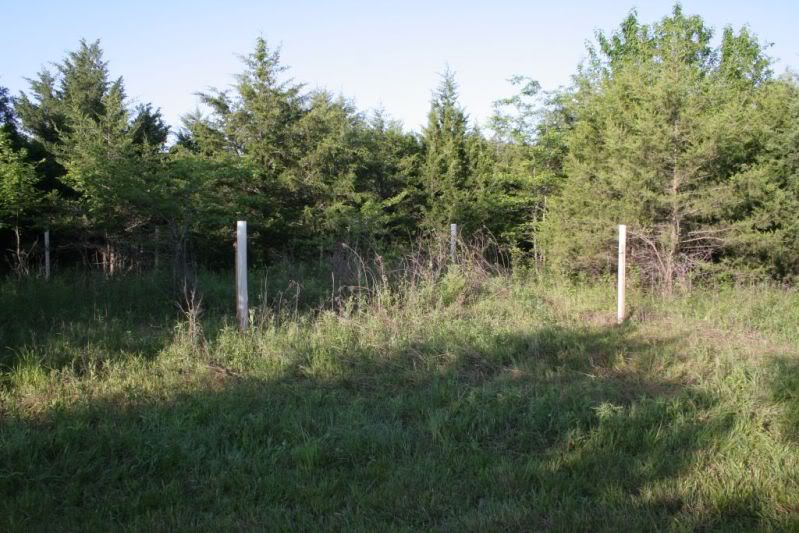

The Kaylor planter does an excellent job



We continue to keep the roots moist during planting

and we always go back and make sure all tree toots are covered and firmly tamped down

In most cases we sprayed glyphosate and Oust XP before planting to kill the sod and then follow up after planting with Simazine and Prowl for further residual control.
Once done with tree plantings we start applying herbicide to established tree plantings...and I use a variety of herbicide options

On fruit trees and shrubs I use the following in a 3 gal BP sprayer....
That mix will burn down most emerged broadleaf weeds, kill annual and perennial grasses and provide season long residual control. I direct spray around trees but...this mix will not kill trees if some gets on the leaves at worst it may cause some burning or spotting on leaves that the mix may get on.
On oaks and conifers I use the same mix but add Oust/Spyder...this mix is deadly and can cause injury if applied over the top of budded or candled trees so I direct spray around base of seedlings if they have broke dormancy as they did very early this year.
Reading back thru this thread you can see that last year I was not able to apply herbicide until June and broadleaf weeds were 2-3' tall so I used 2 qt's each of Simazine and prowl and 1 qt crop oil which not only burned down the existing broadleaves but provided a full year of control.

You cans see the size of the dead weeds still laying on the ground as I sprayed this year

note the unsprayed area to the right of the cedars

and the size of the weed stalks that were killed last summer yet without harming the fully leafed out or candled trees

the question was asked
and this is the labeled response
DO NOT APPLY CLETHODIM if rainfall is expected within one hour, since control may be reduced.
No...there are no restrictions on the use of clethodim on conifers but crop oil may cause some burning to leafed out trees. Clethodim itself will not harm broadleaf plants/trees or conifers but any time crop oil is used (and CO is necessary to make the clethodim effective) it can cause some burning.
Personally I have sprayed clethodim and crop oil on even the most tender, fragile flowers with no adverse affects so the likelihood of serious injury to trees is extremely unlikely....
Another batch of seedlings arrived a few weeks back and of course arrived a few days before we could plant them. I picked up some peat moss...

Mixed it up with water

and added it to the wet newspaper

to be certain the roots stayed moist until we could plant


Compared to hand planting, using a tree planter is a breeze and my son and I put several thousand in the ground in no time

In all cases we planted the cedars for tree screens



The Kaylor planter does an excellent job



We continue to keep the roots moist during planting

and we always go back and make sure all tree toots are covered and firmly tamped down

In most cases we sprayed glyphosate and Oust XP before planting to kill the sod and then follow up after planting with Simazine and Prowl for further residual control.
Once done with tree plantings we start applying herbicide to established tree plantings...and I use a variety of herbicide options

On fruit trees and shrubs I use the following in a 3 gal BP sprayer....
1 qt Simazine
1 qt Prowl
1 qt crop oil
8 ounces clethodim
That mix will burn down most emerged broadleaf weeds, kill annual and perennial grasses and provide season long residual control. I direct spray around trees but...this mix will not kill trees if some gets on the leaves at worst it may cause some burning or spotting on leaves that the mix may get on.
On oaks and conifers I use the same mix but add Oust/Spyder...this mix is deadly and can cause injury if applied over the top of budded or candled trees so I direct spray around base of seedlings if they have broke dormancy as they did very early this year.
1 qt Simazine
1 qt Prowl
1 qt crop oil
8 ounces clethodim
1 ounce Oust XP
Reading back thru this thread you can see that last year I was not able to apply herbicide until June and broadleaf weeds were 2-3' tall so I used 2 qt's each of Simazine and prowl and 1 qt crop oil which not only burned down the existing broadleaves but provided a full year of control.

You cans see the size of the dead weeds still laying on the ground as I sprayed this year

note the unsprayed area to the right of the cedars

and the size of the weed stalks that were killed last summer yet without harming the fully leafed out or candled trees

the question was asked
How long before clethodim is rainfast?
and this is the labeled response
DO NOT APPLY CLETHODIM if rainfall is expected within one hour, since control may be reduced.
Will clethodim hurt candled or leafed out trees?
No...there are no restrictions on the use of clethodim on conifers but crop oil may cause some burning to leafed out trees. Clethodim itself will not harm broadleaf plants/trees or conifers but any time crop oil is used (and CO is necessary to make the clethodim effective) it can cause some burning.
Personally I have sprayed clethodim and crop oil on even the most tender, fragile flowers with no adverse affects so the likelihood of serious injury to trees is extremely unlikely....
dbltree
Super Moderator
Herbicides for Conifers
Depending on the time of year we have a few more herbicide options for conifers then on deciduous tree species and the following is a great link for more info on this subject.
Effective Herbicide Use in Christmas Tree Plantations
The most difficult situation is over the top application when trees are actively growing but here are some options to consider for conifers....
It is always safest to apply while trees are dormant and the fall before new seedlings are planted often the weather and "life" doesn't cooperate so it's nice to have options.
Rarely does any given herbicide label cover every imaginable tree species so apply herbicide over the top of a few trees and check the response before spraying your whole planting and finding out too late that you shouldn't have....
Depending on the time of year we have a few more herbicide options for conifers then on deciduous tree species and the following is a great link for more info on this subject.
Effective Herbicide Use in Christmas Tree Plantations
The most difficult situation is over the top application when trees are actively growing but here are some options to consider for conifers....
ESTABLISHED PLANTATIONS
Over-the-top application when trees are growing:
Fluazifop-butyl (Fusilade 2000). Rate: 2 to 3 pint/acre. Controls annual and perennial grasses but not broadleaf weeds or sedges. Effective in late spring and early summer when grasses are actively growing but before they exceed recommended growth stages. Effectively controls quackgrass when applied before growth exceeds 10 inches. For maximum effectiveness, apply with a non-ionic surfactant in two applications at half the recommended rate. A directed spray is recommended for Fraser fir.
Hexazinone (Velpar L, Pronone 10G). Rate: 0.5 to 1 gallon/acre, 5 to 15 pound/acre. Use only on established (at least 1 year) Scotch pine plantations. Apply when herbaceous vegetation is less than 2 inches high. For best results, apply when soil moisture is ample and both temperature and relative humidity are high.
Sethoxydim (Vantage). Rate: 1.5 to 3.25 pints/acre.Effectively controls quackgrass and late-season annualgrasses. Apply anytime herbaceous vegetation is present, regardless of Christmas tree dormancy. The spray mixture requires a non-phytotoxic oil concentrate at a rate of 2 pints/acre.
Clopyralid (trade name: Stinger). Rate: 0.25 to 0.67 pint/acre. Applied in early summer it controls a number of herbaceous broadleaf weeds such as alfalfa, sweet and red clover, horseweed, sowthistle, Canada thistle and vetch. Applications must be made before susceptible plants exceed recommended growth stages.
It is always safest to apply while trees are dormant and the fall before new seedlings are planted often the weather and "life" doesn't cooperate so it's nice to have options.
Rarely does any given herbicide label cover every imaginable tree species so apply herbicide over the top of a few trees and check the response before spraying your whole planting and finding out too late that you shouldn't have....
dbltree
Super Moderator
Tree Tubes
I am really looking forward to trying tubes that...
A) Don't come apart...period
B) Animals can't chew on or climb up
C) Don't kink over because of weak side walls
E) Don't require assembly
So far I have used both the blue Protex tubes sold by Forestry Suppliers and the Plantra tubes offered thru NWTF and both fail miserably! Now that is not so day they can never work because they can but they have too many weak points to suit me and I have switched to Miracle vented tubes by Tree Pro and sold for $2.50 ea. (100+) by Timber Management LLC
Because the Protex has to be assembled it means there are "flaps" and "edges" that seem to attract critters such as coons who love to chew on them.

The teeth marks are unmistakable

Which means I find them like this

Torn apart and trees either exposed or crushed


Note the chewed off oak seedling re-sprouting (thankfully) just outside the edge of the tube

95% of the problems with critters chewing or climbing on tubes takes place when trees are planted in and around heavy cover and only rarely is it a problem in open field areas. There however wind buffets the tubes and tends to open up the Protex and flatten the Plantra tubes. Some of the problems can be overcome by using ties or wire thru the openings on the Protex and using two posts on the Plantra tubes and wiring thru holes in posts to prevent them from being dragged down. So far 100% of Plantra tubes used in multiple locations on several farms have been dragged down...multiple times I might add!
The Protex tubes fare better in open field areas if they are put together properly and a tie or wire used around the entire tube and stake...if they stay together they do their job and trees do very well in them.
You can see the growth of these Dwarf Chinkapin oaks in these tubes...



On a slightly different note...this is a 2 yr old fall planted DCO seedling (planted in fall 2009 as an acorn)

Compared to Rootmaker started seedlings planted in summer 2010

Other problems that need to be addressed with tree tubes and seedlings in general is depredation by rodents of which the worst can be mice, voles, ground squirrels and rabbits. Keeping the area completely void of weeds is one way to solve that problem. No mouse that wants to live long is going to caught in the open, so a 100% weed/grass free area surrounding the tube will eliminate most of those problems. I would add here that the Plantra tubes are soft and easily chewed thru while heavier tubes such as the Protex and Miracle tubes mice are forced to dig under.
3 years ago I ordered a single weed mat just for the sake of experimentation and used herbicide around it to boot. While on this single tree I have not had a problem...you can see that they are an invitation for burrowing rodents to crawl underneath and kill a young tree...

On the other oak trees I used a combo of Oust XP, Prowl and Simazine and keep the area bare and exposed...an inhospitable environment for mice!

the area around each tube is weed free and trees are growing rapidly in the tubes!

Around my fruit trees last year I sprayed Simazine, Prowl and crop oil on growing grasses and weeds and as noted previously if smoked everything without harming the trees. What is interesting however is the ability for this herbicide cocktail to kill via the roots as well as thru the leaf. Note here where heavy rains last spring caused the herbicide to "run" and it killed everything downhill of where I actually sprayed.
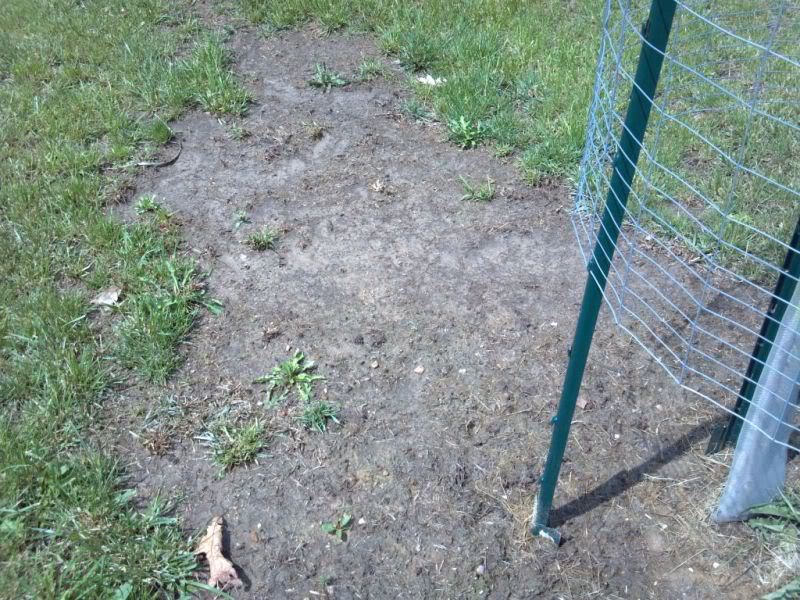
Both herbicides used are residual per-emergence herbicides that are not typically expected to kill weeds post emergence but obviously applied heavy enough the combination has powerful post-emergence capabilities.
Frost and Freeze
We had a freeze back in April when temps dropped to 23 degrees...usually not a problem except with 80 degree temps in March everything was leafed out! Young oaks and chestnuts appeared at first to have been killed with all leaves appearing stone cold dead...
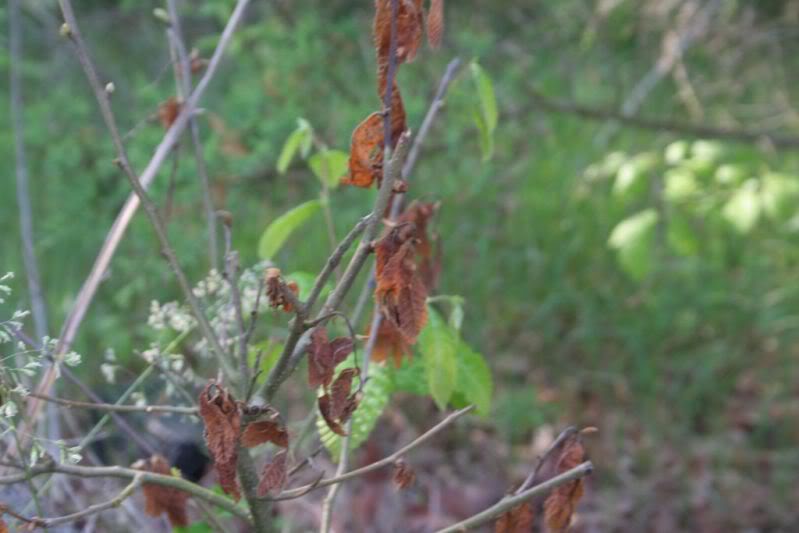
but weeks late all have new leaves
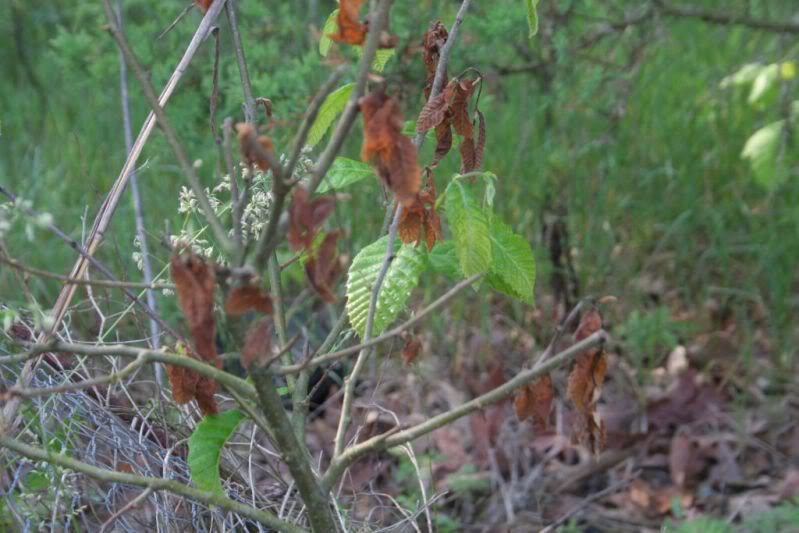
and buds
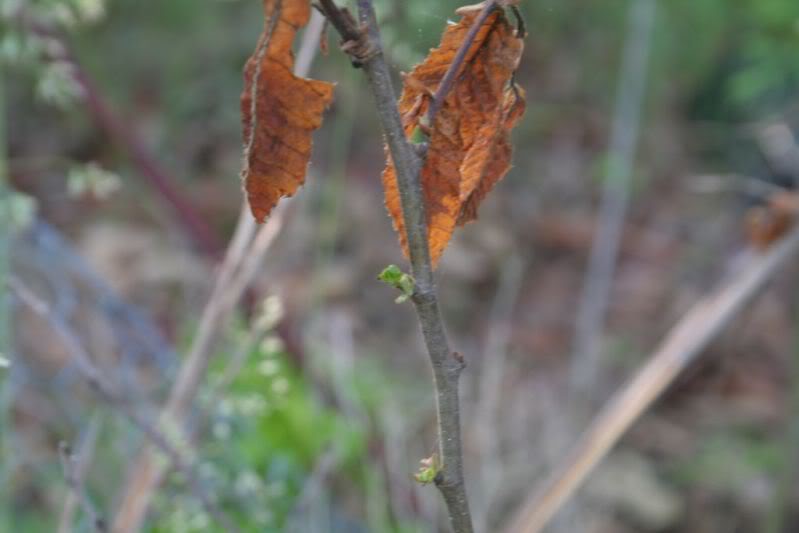
In a recent Oikos Tree Crops news letter they had this to say...
A friend of mine back east recently was mortified to find even his 10 year old chestnut trees all appearing dead after a recent hard freeze to 25 degrees but I believe they will recover in the next few weeks and I'm looking forward to hearing back from him.
I took advantage of a late spring sale at Oikos Tree Crops to buy some potted Ashworth Bur Oak seedlings for a buck a piece along with some Schuttes Oak and ‘Sweet it Is’ bur oaks so when they arrive I'll be tubing them with the Miracle tubes and start testing them with what I hope are....better results! :way:
I am really looking forward to trying tubes that...
A) Don't come apart...period
B) Animals can't chew on or climb up
C) Don't kink over because of weak side walls
E) Don't require assembly
So far I have used both the blue Protex tubes sold by Forestry Suppliers and the Plantra tubes offered thru NWTF and both fail miserably! Now that is not so day they can never work because they can but they have too many weak points to suit me and I have switched to Miracle vented tubes by Tree Pro and sold for $2.50 ea. (100+) by Timber Management LLC
Because the Protex has to be assembled it means there are "flaps" and "edges" that seem to attract critters such as coons who love to chew on them.

The teeth marks are unmistakable

Which means I find them like this

Torn apart and trees either exposed or crushed


Note the chewed off oak seedling re-sprouting (thankfully) just outside the edge of the tube

95% of the problems with critters chewing or climbing on tubes takes place when trees are planted in and around heavy cover and only rarely is it a problem in open field areas. There however wind buffets the tubes and tends to open up the Protex and flatten the Plantra tubes. Some of the problems can be overcome by using ties or wire thru the openings on the Protex and using two posts on the Plantra tubes and wiring thru holes in posts to prevent them from being dragged down. So far 100% of Plantra tubes used in multiple locations on several farms have been dragged down...multiple times I might add!
The Protex tubes fare better in open field areas if they are put together properly and a tie or wire used around the entire tube and stake...if they stay together they do their job and trees do very well in them.
You can see the growth of these Dwarf Chinkapin oaks in these tubes...



On a slightly different note...this is a 2 yr old fall planted DCO seedling (planted in fall 2009 as an acorn)

Compared to Rootmaker started seedlings planted in summer 2010

Other problems that need to be addressed with tree tubes and seedlings in general is depredation by rodents of which the worst can be mice, voles, ground squirrels and rabbits. Keeping the area completely void of weeds is one way to solve that problem. No mouse that wants to live long is going to caught in the open, so a 100% weed/grass free area surrounding the tube will eliminate most of those problems. I would add here that the Plantra tubes are soft and easily chewed thru while heavier tubes such as the Protex and Miracle tubes mice are forced to dig under.
3 years ago I ordered a single weed mat just for the sake of experimentation and used herbicide around it to boot. While on this single tree I have not had a problem...you can see that they are an invitation for burrowing rodents to crawl underneath and kill a young tree...

On the other oak trees I used a combo of Oust XP, Prowl and Simazine and keep the area bare and exposed...an inhospitable environment for mice!

the area around each tube is weed free and trees are growing rapidly in the tubes!

Around my fruit trees last year I sprayed Simazine, Prowl and crop oil on growing grasses and weeds and as noted previously if smoked everything without harming the trees. What is interesting however is the ability for this herbicide cocktail to kill via the roots as well as thru the leaf. Note here where heavy rains last spring caused the herbicide to "run" and it killed everything downhill of where I actually sprayed.

Both herbicides used are residual per-emergence herbicides that are not typically expected to kill weeds post emergence but obviously applied heavy enough the combination has powerful post-emergence capabilities.
Frost and Freeze
We had a freeze back in April when temps dropped to 23 degrees...usually not a problem except with 80 degree temps in March everything was leafed out! Young oaks and chestnuts appeared at first to have been killed with all leaves appearing stone cold dead...

but weeks late all have new leaves

and buds

In a recent Oikos Tree Crops news letter they had this to say...
FROST DAMAGE
After this last cold snap it is important to note that frost damaged seedlings will grow again and unlike annuals are often invigorated by the process. The storage of energy in the roots will produce a re-leafing often more vigorous than the first time around. Unless very severe low temperatures are experienced, only the new leaves are burned. The complete vascular system of the plant is not destroyed so the stems will still be green. (You can do a simple scratch test to check this.) Some plants, like oaks will further increase root mass when soil temperatures drop.
A friend of mine back east recently was mortified to find even his 10 year old chestnut trees all appearing dead after a recent hard freeze to 25 degrees but I believe they will recover in the next few weeks and I'm looking forward to hearing back from him.
I took advantage of a late spring sale at Oikos Tree Crops to buy some potted Ashworth Bur Oak seedlings for a buck a piece along with some Schuttes Oak and ‘Sweet it Is’ bur oaks so when they arrive I'll be tubing them with the Miracle tubes and start testing them with what I hope are....better results! :way:
